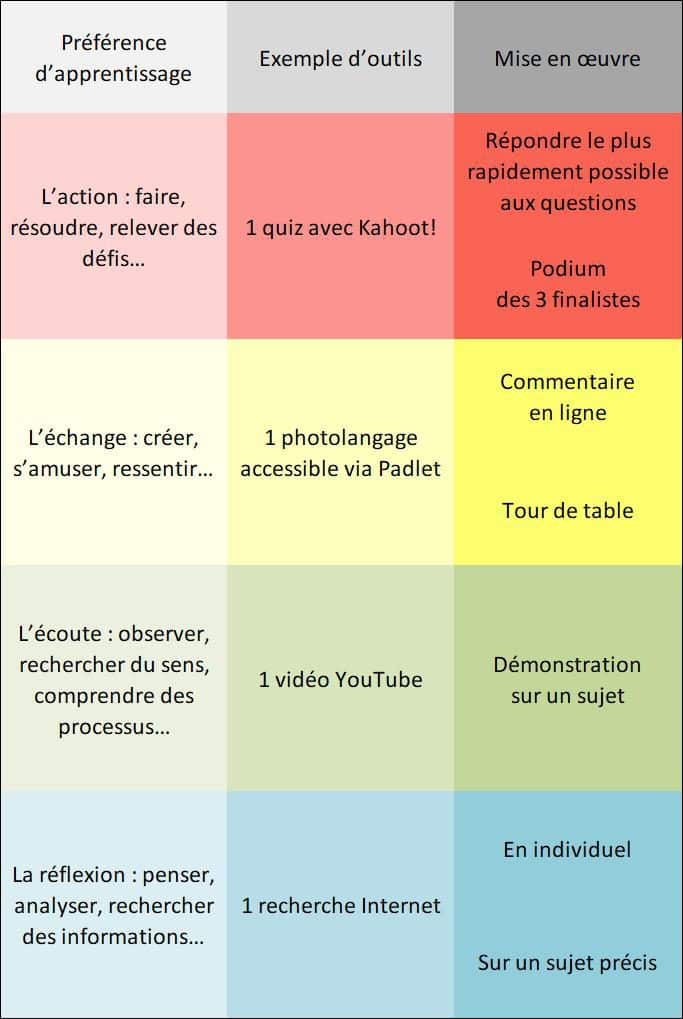Distance learning courses, or virtual classes, have become a must. Saving time (no need to travel) and the possibility of teleworking are the two major advantages. But it is said that commitment is more difficult for participants... True and false at the same time. In fact, everything depends on the training practices used by the trainers to make the distance learning class dynamic and stimulating. So how do trainers keep learners' attention? And how do they ensure that they develop their skills? Exploring best practice with trainer Marine Gandouet.

Distance learning: appropriate teaching methods
Research by John Medina, a professor at Washington State University, shows that an adult's attention span drops by 80 % after 10 minutes. In training, it is therefore essential to implement appropriate teaching methods to capture the attention of learners and encourage memorisation.
Towards more active and collaborative methods
The more the participants create the knowledge themselves, the more they will experiment, understand, memorise and transpose the information. The lecturing/descending method should therefore be used sparingly, especially in distance learning.
What is a distance learning class?
In contrast to face-to-face training, in a distance learning class, participants and trainer are not in the same room. A videoconferencing system (Teams...) allows them to meet virtually. This is why we also talk about virtual classroom.
In other words, distance learning enables several participants to follow the same trainingfrom a distance, but in real time (same days, same times). Participants and the trainer can see each other, talk to each other, take part in interactive activities together and exchange documents. Distance learning is therefore different from e-learning modules, which are pre-recorded courses that can be consulted at any time, without direct interaction with a trainer or other learners.
It is necessary to create a stimulating and effective learning environment. The trainer also becomes a facilitator.
Trainers can use 3 levers:
1/ Encouraging learner involvement
For example: gathering their expectations, giving meaning to the training, helping them to situate themselves in terms of their knowledge and learning, transposing the new skills to future professional activities, verbally valuing their contributions/participations, encouraging them to ask questions, etc.
2/ Promote learner collaboration
Example: Encourage collaboration by using collaborative working tools such as virtual whiteboards or online chat rooms with an exercise where everyone has a role to play. role (time management, script, spokesperson, etc.).
3/ Maintaining attention by creating rhythm
Example: integrate interactive elements into the teaching process, such as live polls, quizzes, games, videos, brainstorming sessions, etc.
[ Read also ]
Promoting an effective learning strategy with Triple A
It's the perfect ally for structuring and energising training courses: Triple A. It breaks down into 3 phases: "Appeal", "Contribution" and "Anchoring".
Call
This is the activation phase, designed to arouse learners' interest and/or measure their level of knowledge about the subject to come.
Examples of how to make a "call":
- Show a powerful image
- Start a brainstorm
- Take a survey
- Show a video
- Use photos and have one chosen (photolanguage)
- Tell an anecdote
Bring
This is the acquisition phase. The key concepts, information or skills that learners need to acquire are presented. With the active method, the trainer can prepare the course so that it is the learners who create the knowledge.
Examples of how to make a "contribution":
- Explain key concepts with a support
- Exploring a case study together
- Give a demonstration
- Explore a personalised deck of cards
- Do a search on the Internet
- Show a video
Anchoring
This is the application phase. It is designed to help learners integrate the new learning and to check the learning progress.
Examples of "anchoring":
- Scenario
- Role-playing game
- Case studies
- Quiz
- Exercise
- A range of digital games for revising concepts (gap-fill text, spinning wheel, crosswords, revision sheets, cards to sort into groups, etc.) See the site https://wordwall.njet
Funny Learning®
Funny Learning® offers a learner-centred approach to teaching that enables the needs of each individual to be met, even in very large groups.
This teaching method is based in particular on the 4 learning preferences in training situations: Observation, Action, Sharing, Reflection.
Everyone has unconscious preferences for learning. Preferences that differ from one person to another. By default, a trainer may therefore tend to lead according to his own preferences. However, they must also take into account other preferences and adjust to those of the participants.
4 learning preferences

Good practice? Use digital tools to alternate learning preferences throughout the day. In this way, each participant will benefit from training sequences adapted to their learning preferences.
Assessing learners and achieving objectives: in the distance learning classroom too!
While capturing learners' attention and facilitating memorisation are important, so is ensuring that each learner's skills are enhanced, particularly in a virtual classroom.
3 key moments for assessment
Predictive evaluation :
Before or at the start of the training course, it is important to establish where the participant is coming from: what knowledge, representations and experience they have on the subject.
Implementation :
→ with a self-positioning questionnaire, quiz or survey
Formative assessment :
This takes place throughout the course, and can be verified by means of the 3rd "A" of the "triple A": Anchoring.
Implementation :
→ with a situation, a quiz, an exercise, etc.
Summative assessment :
Its aim is to assess learners' final and overall skills development at the end of a learning period.
Implementation :
→ final quiz, final case study, role play, summary...
In addition to the 3 evaluation sessions, participants' expectations are a crucial element of the training.
The common thread of the individual expectations of the participants
This involves making the link at various key moments as to "why" the participants are doing the training. On the one hand, this enables the trainer to give sense, and therefore motivate participants to get involved. On the other hand, it allows them to better guide and personalise the training as they go along. These two aspects help participants to achieve their objectives more effectively.
here are key moments to collect expectations:
- At the start of the course : digital post-its, in chat, taking notes on the whiteboard or in a mind map.
- Throughout the training "Making the link: "Where do you stand in terms of your expectations? Where do you stand? What do you need? During distance learning, the trainer can ask questions orally, use chat, or even use images or characters to help participants find their bearings.
- At the end of the course : verbally, by going back over the notes of each participant and asking: "What are you leaving with?", "Where do you stand in relation to your initial expectations, after 2 days of training?
Distance learning: making the most of interactive tools
How do trainers choose the right digital tools for virtual classes?
The trick with digital tools is not to lose the connection and the attention of the participants. Either because the tools used are too numerous. Or because they don't know how to use the tool. Using too many tools or the wrong tool can also make learning more complex. That's why the trainer doesn't choose them at random, but to achieve a specific objective.
Which tool for which educational purpose?
| Educational aims | Examples of digital tools |
|---|---|
| Preparing for training in advance | Google Forms Forms DragnSurvey |
| Structuring training and encouraging follow-up | Padlet to display the complete lesson plan |
| Energising the group | Genially to create a serious game Wordwall with the random wheel: visual and sound effects guaranteed! |
| Introduce a subject (arouse curiosity, take the temperature of participants' knowledge) | YouTube to watch a video Edpuzzle for designing a video quiz Wooclap to create a survey |
| Provide content for participants with dynamic or punchy presentations | Genially for an interactive presentation or image Prezi for an innovative presentation |
| Anchoring learning | Wooclap or Kahoot! for a quiz Hummingbird post-it notes: participants write on digital post-it notes what they remember from the sequence. |
In distance learning, even more than in face-to-face training, the best training practices for participants focus on engagement, collaboration and maintaining attention. The Triple A concept (Call, Contribute, Anchor) provides a guide for effectively structuring training courses. The Funny Learning® method offers a learner-centred approach adapted to different learning preferences. Assessment is crucial at every stage of the training. Finally, it is important to choose the right digital tools for specific learning purposes.
[Expert voice]
"What I like most about distance learning is seeing the group cohesion that develops behind the screens.
Marine Gandouet, trainer
For me, leading training Training differently: running a virtual classroom is special because I'm talking to my peers. I take pleasure in saying this to them right from the start of the course. I tell them that this training course is twofold for me: "they are both participants and observers of my practices. What they like about my facilitation, they can keep for themselves. What they like less, they won't keep. We're on the same level. I too will be learning from them over these 2 days.
One of the difficulties I encountered during a recent session: maintain visual/sound contact with learners.
Two of them turned off their cameras because they didn't have enough WiFi bandwidth. This is indeed advisable in such cases. As I couldn't see them, I went to very vigilant in regularly contacting them. For example: "Is everything going well for you Enora?", "Where are you in the exercise? During brief exchanges, they were able to turn their cameras back on. Their intention was to maintain the link. Another participant had no sound at one point. I asked him to call me on my phone, put him on the loudspeaker and the group could hear him speak.
Virtual classroom training also means knowing how to adapt to technical contingencies. And that requires creativity trainers.
2 things I like best about the virtual classroom
- See it group cohesion behind the screens.
- To have some positive feedback on the use of digital tools by the participants: they're often surprised that it can be so dynamic!





